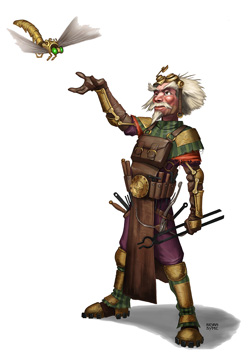
Throughout this series, we’ve covered several best practices for one-on-one play, and we hope that you’ve been able to put them to use at your own gaming table! But there’s one topic we haven’t yet covered: adapting published campaigns for one-on-one play.
And that’s what this post is all about! First, we’ll talk about some guiding principles for adapting a published campaign. How do we take adventures scaled for groups and suit them to a two-person table? Then we’ll ask what story tweaks do we need to make in order to focus on a single PC instead of a whole party?
Adaptation Principles
As we said earlier in this series, one of the best things about one-on-one play is the focus on the player and the PC. They’re the main character around whom the entire storyline revolves. This is a double-edged sword when it comes to adapting a published campaign though. Both the narrative arc and encounter scale have been designed with a group in mind.
Scale, which we’ve written about previously, is the easier adjustment of the two. But how do we go about shifting the story?
The easiest answer is that we return to basics: we lean on a GMPC, and we also set the player up with knowledge about the campaign, so they can make as fitting a PC as possible.
Joining Story and PC
In an ideal world for campaign adaptation, we would start with either the campaign and then assist the player in creating their PC or we would start with the PC and choose a fitting campaign for them.
So if you’re starting with the campaign first, GMs, you’ll want to share the important themes and setting with the player alongside a few clues about the overarching conflict. Is there a lot of political intrigue? Will there be quite a bit of detective work? Might the PC want to have a hobby, so they can stay entertained during downtime activities? Or are we working with a classic adventure situation where we charge out and face all of the dragons as heroically as possible?
On the flip side, if you’re starting with the PC, you’ll want to think about the inner questions they’re trying to answer—what drives this character? Are they on a quest to prove themselves? What do they most value? What does the character think they most need versus what do they actually need? (That last question is one of my favorites for character development. For instance, a character who thinks they need freedom but who actually needs community has a lot to learn over the course of their adventures in order to defeat the monsters inside and out.)
But what if the character-creation process and the campaign-adaptation process are occurring relatively simultaneously?
The Big Question
When adapting the story of a published campaign to your table, and specifically to the PC, it really comes down to figuring out why the PC wants to go on this adventure and helping to foster that as best you can. The challenge for both the player and the GM in this scenario is to uncover the PC’s motivations and then give them the space to explore those drives.
If the PC isn’t sure what they really want, that’s alright! You can try out a few different calls to adventure and see what seems to stick. Experiment with different rewards, like friendship, acclaim, gold, and magical items (though not all at once but in differing combinations). What excites the PC the most?
There are two other drivers we can lean on here, and both are character related.
GMPCs for the Win
First, GMs, see if you can create a GMPC based on the existing characters in the campaign. It’s pretty common for there to be NPCs already waiting to guide a party in the story world. Which of them (or some conglomeration of several) seems most likely to join this particular PC on their quest?
If you’re okay with keeping things more open, you might put a few different characters in front of the PC and see who resonates with them the most.
Villainous Ends
Nothing sparks that sense of adventure quite like a powerful villain. If it seems like the story isn’t gripping the PC as strongly as you would like, see if you can arrange an early appearance for the BBEG or one of their minions. This doesn’t need to be a devastating encounter for the PC, but it should be enough to spark whatever force called them to adventure in the first place.
You might even consider arranging a brief monologue for your villain, leaving the hero with a challenge and a thirst for a second conflict. But before they can face the villain again, the hero will need to prove themselves in a few smaller challenges. Perhaps the GMPC can even help show the way.
Additional Resources
For more tips on designing single-PC campaign arcs, click here.
We hope this has given you some ideas for adapting a published campaign for one-on-one play! To read additional tips and tricks, check out the other posts in this series.
___
You can find more advice and ideas for one-on-one play at dndduet.com.
